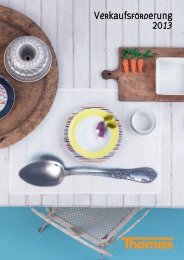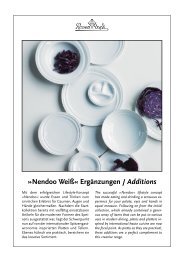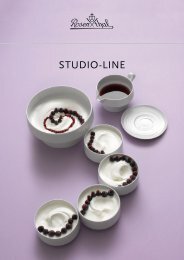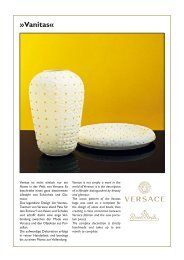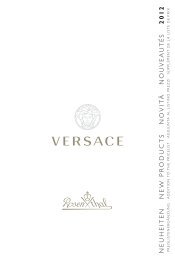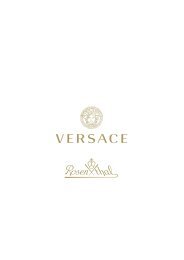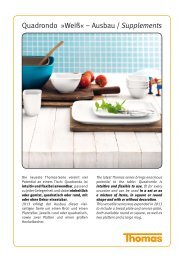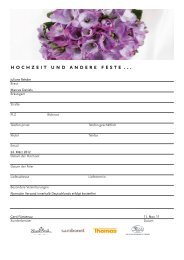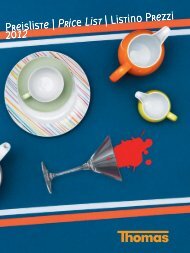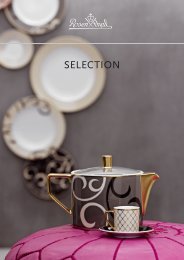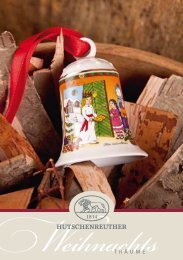Rosenthal Essential Magazin
Rosenthal Essential Magazin
Rosenthal Essential Magazin
Erfolgreiche ePaper selbst erstellen
Machen Sie aus Ihren PDF Publikationen ein blätterbares Flipbook mit unserer einzigartigen Google optimierten e-Paper Software.
A somewhat alternative diet<br />
Nerve bread, barley sausage and Iceland moss<br />
pudding? Not necessarily things you would commonly<br />
associate with the guiding light in German<br />
design. If we think of eating and the Bauhaus, then<br />
we think of the Bauhaus canteen in Dessau, the<br />
elegant tea service of Marianne Brandt and simple<br />
ceramics of Theodor Bogler. All very aesthetically<br />
pleasing.<br />
Anyone who thought that this was the case everywhere<br />
in the Bauhaus would be wrong – for quite a<br />
few Bauhaus members lived by the ascetic rules of<br />
mazdaznan teachings. As well as regular meditation<br />
and other strict rituals, these also prescribed a rigid<br />
vegetarian diet in order to create a balance between<br />
mind and body. it was therefore quite possible for<br />
someone’s ascetic over-enthusiasm to cause their<br />
complexion to turn an unhealthy green colour. the<br />
clouds of garlic that would sometimes surround a<br />
mazdaznan follower were also legendary. yet people<br />
in the Bauhaus did not just float around on a higher<br />
plain, it sometimes involved quite practical aspects<br />
when it came to eating. For example, students received<br />
meals funded with donations and had their<br />
own garden. home-grown produce was harvested<br />
there, then cooked and eaten together.<br />
Das Tee-Extraktkännchen MT 49 wurde 1924<br />
von Marianne Brandt entworfen. Geometrischskulptural<br />
anmutend in der Form, kombiniert<br />
die Gestalterin die Materialien Messing, Silber<br />
und Ebenholz.<br />
At the table<br />
Correct nutrition and food preparation, but also the<br />
production of functional and aesthetic products for<br />
the dinner table, represented important themes in<br />
weimar and dessau. “First, a person must have a<br />
well-proportioned figure – only then can the artist<br />
design beautiful clothing for him […],” stated walter<br />
Gropius. when we think of the Bauhaus today, we<br />
tend to think of beautiful items for the dinner table<br />
rather than an ascetic lifestyle. the clear geometrical<br />
shapes and strict lines of the porcelain, glass<br />
and metal items produced in the Bauhaus workshops<br />
are still in keeping with the times.<br />
In the kitchen<br />
however, the Bauhaus members were not just concerned<br />
with nutrition and designing kitchen utensils,<br />
they also designed entire kitchens according to<br />
their strict design and reformist principles – as seen<br />
in the haus am horn in weimar designed by Georg<br />
muche in 1923. various Bauhaus workshops were<br />
involved in designing this building, complete with<br />
interiors containing furniture and objects. Benita<br />
Koch-otte and ernst Gebhardt designed the kitchen<br />
as a pure working space with well-thought-out<br />
workflows – contrary to the open-plan kitchen are-<br />
The MT 49 tea infuser was designed by Marianne<br />
Brandt in 1924. With a geometrically sculptural<br />
appearance, the designer combined brass, silver and<br />
ebony wood in the infuser.<br />
8 | 9<br />
Aufgebaut auf geometrische Grundformen und<br />
stilistisch dem Bauhaus verpflichtet ist die Teekanne<br />
TAC, die Walter Gropius Ende der sechziger<br />
Jahre für <strong>Rosenthal</strong> gestaltet hat. Er war zuvor<br />
bereits als Architekt für das Unternehmen<br />
tätig.<br />
The TAC teapot, which Walter Gropius designed for<br />
<strong>Rosenthal</strong> towards the end of the 1960s, is built<br />
upon basic geometrical forms and owes its style to<br />
the Bauhaus. Gropius had already worked as an<br />
architect for the company previously.<br />
as seen in traditional homes. the room, which was<br />
equipped with a fitted kitchen, not only had a separate<br />
pantry and broom cupboard, it also included<br />
an electric boiler for heating water and a gas oven<br />
– items which represented state-of-the-art technology<br />
at that time. the aim was to relieve women of<br />
their traditional housework duties.<br />
But let’s return to the nerve bread, barley sausage<br />
and iceland moss pudding. Architecture and design<br />
pilgrims recently had the chance to sample the sometimes<br />
strange flavours of the Bauhaus in the<br />
Kornhaus restaurant in dessau. housed in a building<br />
designed by one of Gropius’ students, Carl Fieger,<br />
and surrounded by Bauhaus furniture and memorabilia,<br />
a veritable mazdaznan feast appeared<br />
on the restaurant’s menu, alongside foods such as<br />
schnitzel, chips and herring in cream sauce.



